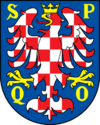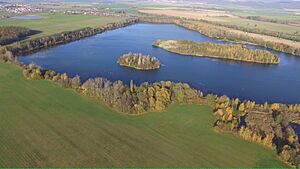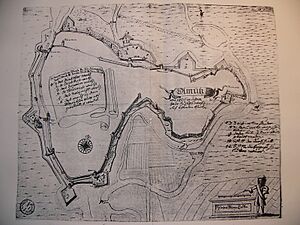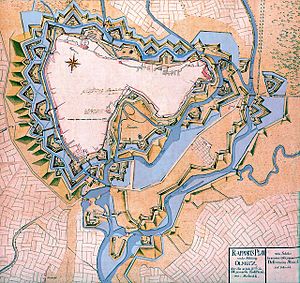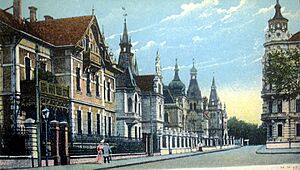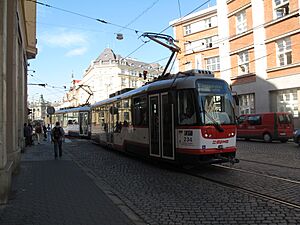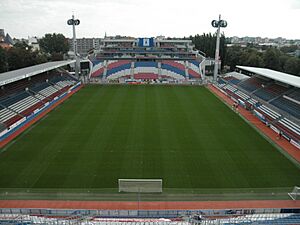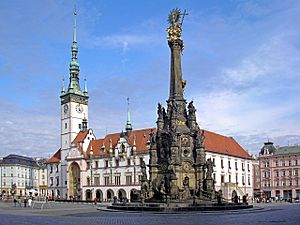Olomouc facts for kids
Quick facts for kids
Olomouc
|
|||||
|---|---|---|---|---|---|
|
Statutory city
|
|||||
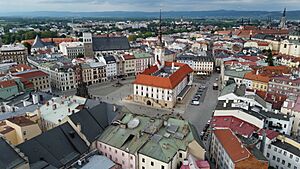
Horní Square, the historic city centre (left: Holy Trinity Column; middle: Olomouc City Hall)
|
|||||
|
|||||
| Country | |||||
| Region | Olomouc | ||||
| District | Olomouc | ||||
| First mentioned | 1017 | ||||
| Area | |||||
| • Total | 103.33 km2 (39.90 sq mi) | ||||
| Elevation | 219 m (719 ft) | ||||
| Population
(2024-01-01)
|
|||||
| • Total | 102,293 | ||||
| • Density | 989.96/km2 (2,564.00/sq mi) | ||||
| Time zone | UTC+1 (CET) | ||||
| • Summer (DST) | UTC+2 (CEST) | ||||
| Postal code |
779 00
|
||||
| UNESCO World Heritage Site | |||||
| Official name | Holy Trinity Column in Olomouc | ||||
| Criteria | i, iv | ||||
| Inscription | 2000 (24th Session) | ||||
Olomouc (pronounced OH-loh-mohts) is a city in the Czech Republic. It has about 102,000 people living there, making it the sixth largest city in the country. Olomouc is the main city of the Olomouc Region.
The city is located on the Morava River. It was once a very important religious and historical capital of Moravia. The historic city center is very well kept. It is even protected by law as a special "urban monument reservation." The Holy Trinity Column is a famous landmark. It was added to the UNESCO World Heritage Site list in 2000. This column is known for its beautiful Baroque style and its special meaning.
Contents
What is Olomouc Like?
City Parts and Divisions
Olomouc is divided into 26 smaller parts. These parts help manage the city.
- Olomouc
- Bělidla
- Černovír
- Chomoutov
- Chválkovice
- Droždín
- Hejčín
- Hodolany
- Holice
- Klášterní Hradisko
- Lazce
- Lošov
- Nedvězí
- Nemilany
- Neředín
- Nová Ulice
- Nové Sady
- Nový Svět
- Pavlovičky
- Povel
- Radíkov
- Řepčín
- Slavonín
- Svatý Kopeček
- Topolany
- Týneček
Where Does the Name Come From?
No one is completely sure where the name Olomouc comes from. One idea is that it came from a personal name, "Olmút." This would mean "Olmút's castle" or "Olmút's court." Another idea suggests it comes from old Slavic words meaning "beer" and "to make noise."
There's also a legend that Julius Caesar founded a Roman fort here. It was supposedly called Iuliomontium. The legend says Olomouc got its name from this. While archaeologists have found signs of a Roman camp, the story about Julius Caesar is just a legend from the Renaissance period.
Geography and Nature
Olomouc is about 61 kilometres (38 mi) northeast of Brno and 200 km (120 mi) southeast of Prague. It sits mostly on flat, fertile land in the Upper Morava Valley. Some eastern parts of the city extend into the Nízký Jeseník mountains. The highest point in Olomouc is a hill at 444 m (1,457 ft) above sea level. The Litovelské Pomoraví Protected Landscape Area is also partly within Olomouc to the north.
The Morava River flows through the city. The Mlýnský potok stream, which is a branch of the Morava, also runs through Olomouc. The Bystřice river joins the Morava in the city center. The Oskava river briefly forms the northern border before joining the Morava.
Chomoutovské Lake is in the northern part of the city. It was formed when a gravel quarry flooded. This lake is 85 ha (210 acres) big and is a protected nature area. It's an important stop for birds that migrate. It also has one of the largest groups of black-headed gulls and Mediterranean gulls in the country.
Climate
Olomouc has a climate with warm summers and cold winters. The average temperature for the year is 9.6 °C (49.3 °F). July is the warmest month, averaging 20.3 °C (68.5 °F). January is the coldest, averaging −1.4 °C (29.5 °F). The city gets about 532.3 millimetres (20.96 in) of rain each year. July is the wettest month, and February is the driest. Temperatures have ranged from a very cold −27.9 °C (−18.2 °F) in January 2006 to a very hot 37.2 °C (99.0 °F) in August 2013.
| Climate data for Olomouc-Holice, 1991–2020 normals, extremes 1961–present | |||||||||||||
|---|---|---|---|---|---|---|---|---|---|---|---|---|---|
| Month | Jan | Feb | Mar | Apr | May | Jun | Jul | Aug | Sep | Oct | Nov | Dec | Year |
| Record high °C (°F) | 16.7 (62.1) |
17.6 (63.7) |
23.7 (74.7) |
29.2 (84.6) |
31.5 (88.7) |
35.1 (95.2) |
36.4 (97.5) |
37.2 (99.0) |
32.3 (90.1) |
26.9 (80.4) |
20.7 (69.3) |
14.2 (57.6) |
37.2 (99.0) |
| Mean daily maximum °C (°F) | 1.4 (34.5) |
3.9 (39.0) |
9.0 (48.2) |
16.0 (60.8) |
20.4 (68.7) |
23.9 (75.0) |
26.3 (79.3) |
26.2 (79.2) |
20.4 (68.7) |
13.9 (57.0) |
7.5 (45.5) |
2.3 (36.1) |
14.3 (57.7) |
| Daily mean °C (°F) | −1.4 (29.5) |
0.3 (32.5) |
4.3 (39.7) |
10.3 (50.5) |
14.9 (58.8) |
18.4 (65.1) |
20.3 (68.5) |
19.9 (67.8) |
14.7 (58.5) |
9.3 (48.7) |
4.5 (40.1) |
−0.1 (31.8) |
9.6 (49.3) |
| Mean daily minimum °C (°F) | −4.3 (24.3) |
−3.2 (26.2) |
−0.1 (31.8) |
4.2 (39.6) |
8.9 (48.0) |
12.4 (54.3) |
14.0 (57.2) |
13.8 (56.8) |
9.7 (49.5) |
5.4 (41.7) |
1.6 (34.9) |
−2.7 (27.1) |
5.0 (41.0) |
| Record low °C (°F) | −27.9 (−18.2) |
−24.6 (−12.3) |
−18.0 (−0.4) |
−7.2 (19.0) |
−1.9 (28.6) |
2.1 (35.8) |
4.4 (39.9) |
1.4 (34.5) |
−1.7 (28.9) |
−7.2 (19.0) |
−15.6 (3.9) |
−22.0 (−7.6) |
−27.9 (−18.2) |
| Average precipitation mm (inches) | 23.6 (0.93) |
21.5 (0.85) |
29.9 (1.18) |
33.6 (1.32) |
58.4 (2.30) |
66.3 (2.61) |
78.7 (3.10) |
60.9 (2.40) |
56.3 (2.22) |
39.4 (1.55) |
34.7 (1.37) |
29.0 (1.14) |
532.3 (20.96) |
| Average snowfall cm (inches) | 12.1 (4.8) |
7.3 (2.9) |
3.2 (1.3) |
0.6 (0.2) |
0.0 (0.0) |
0.0 (0.0) |
0.0 (0.0) |
0.0 (0.0) |
0.0 (0.0) |
0.0 (0.0) |
2.9 (1.1) |
9.0 (3.5) |
35.1 (13.8) |
| Average relative humidity (%) | 85.7 | 81.1 | 74.2 | 65.6 | 68.0 | 69.3 | 67.4 | 67.4 | 74.9 | 81.3 | 85.7 | 86.6 | 75.6 |
| Mean monthly sunshine hours | 47.5 | 77.0 | 132.7 | 201.1 | 235.6 | 238.0 | 252.8 | 247.9 | 173.1 | 107.6 | 52.5 | 37.9 | 1,803.7 |
| Source: Czech Hydrometeorological Institute | |||||||||||||
A Look at Olomouc's Past
Early History
As far back as the 7th century, an early Slavic settlement grew in the area of today's Povel quarter. This was likely an important administrative center. This settlement was later taken over and disappeared around the early 9th century.
A new center then grew in Předhradí, which was the eastern part of the medieval city. This new settlement survived even after the fall of Great Moravia around 907. It slowly became the capital of the Moravia region.
Between 981 and 990, the Polish Duke Mieszko I took control of Olomouc. This was because it was an important place where trade routes crossed. The city was likely mentioned around 991 as Alemura. Moravia was part of Poland from 1003 to 1031. The first clear mention of Olomouc as a city is from 1017. Moravia came under Bohemian rule starting in 1031.
The bishopric of Olomouc was created in 1063. This was a very important religious center. It later became an archbishopric in 1777. The bishop's palace, built in the Romanesque style, is still one of Olomouc's most valuable buildings. The bishopric owned a lot of land and was very wealthy.
Olomouc became one of the most important places in Moravia. It was a seat of government for the Přemyslid rulers. In 1306, King Wenceslas III was assassinated here. With his death, the Přemyslid royal family ended.
The city was officially founded in the mid-13th century. It became a major center for trade and power. In the Middle Ages, it was the biggest town in Moravia. It even competed with Brno to be the capital. Olomouc lost its top spot after the Swedes took the city during the Thirty Years' War. They held it for eight years (1642–1650).
In 1235, the Mongols invaded Europe. After a battle in Poland, the Mongols attacked Moravia. However, they were stopped and defeated at the strong city of Olomouc.
In 1454, the city asked its Jewish residents to leave. The late 1400s were a "golden age" for Olomouc. Many royal meetings happened here. In 1469, Matthias Corvinus was chosen as King of Bohemia here. In 1479, two kings of Bohemia met in Olomouc. They signed an agreement to divide the country.
Modern Times
During the Thirty Years' War, in 1640, Olomouc was taken by the Swedes. They stayed for eight years. When they left, the city was in ruins. Because of this, Olomouc lost its leading position in Moravia to Brno.
In 1740, the city was briefly captured by the Prussians. Maria Theresa later strengthened Olomouc's defenses. During wars with Frederick the Great, he tried to take the city in 1758 but failed after seven weeks. In 1848, Emperor Ferdinand gave up his throne in Olomouc. Two years later, Austrian and German leaders met here. They agreed to bring back the German Confederation.
In 1746, the first learned society in the lands ruled by the Austrian Habsburgs was started in Olomouc. It was called the Societas eruditorum incognitorum in terris Austriacis. Its goal was to share new ideas from the Enlightenment. Its monthly magazine was the first scientific journal published in the Habsburg empire.
Over time, Olomouc was influenced by German culture. This was partly because of its connections to Austria. However, the Czech language remained strong, especially in religious books. But as more German-speaking people moved to the area, the use of Czech decreased. By the 1800s, there were three times more German speakers than Czech speakers in the city.
After the 1848 revolution, Jewish people were allowed to return to the city. They had been expelled in 1454. In 1897, they built a synagogue. By 1900, the Jewish population reached 1,676.
Olomouc kept its defensive city walls until the late 1800s. The city leaders liked this because it kept the city from growing too much. They wanted Olomouc to stay smaller and mostly German-speaking. The city grew much more after World War I and the creation of Czechoslovakia. In 1919, Olomouc added two nearby towns and 11 villages. This gave it new space to grow.
During both world wars, there were strong disagreements between Czech and German people. During World War II, the city was under German occupation. Many German residents supported the Nazis. The German-run city council even renamed the main square after Adolf Hitler. World War II brought a rise in anti-Jewish feelings and attacks. On November 10, 1938, the city's synagogue was destroyed. In March 1939, city police arrested 800 Jewish men. Some were sent to camps. From 1942 to 1943, the remaining Jewish people were sent to other camps. Fewer than 300 of the city's Jewish residents survived this terrible time. The Germans also had a prison and a labor camp in the city.
After Olomouc was freed, the city square got its original name back. When the German army left the city at the end of the war, they shot at its 15th-century astronomical clock. Only a few pieces survived. The city became part of Czechoslovakia again. In the 1950s, the clock was rebuilt. It now shows workers instead of saints. After the war, many German-speaking residents left the country. This happened as borders in Central Europe were changed. In 1990, after the "Velvet Revolution," a statue of the first president, T. G. Masaryk, was rebuilt. This symbolized the return of democracy. Olomouc's inner city is the third-largest protected urban area in the country, after Prague.
Population Changes
| Historical population | ||||||||||||||||||||||||||||||||||||||||||||||||||||||||
|---|---|---|---|---|---|---|---|---|---|---|---|---|---|---|---|---|---|---|---|---|---|---|---|---|---|---|---|---|---|---|---|---|---|---|---|---|---|---|---|---|---|---|---|---|---|---|---|---|---|---|---|---|---|---|---|---|
|
|
|
||||||||||||||||||||||||||||||||||||||||||||||||||||||
| Source: Censuses | ||||||||||||||||||||||||||||||||||||||||||||||||||||||||
Economy and Growth
The Olomouc area is a special zone for getting money from European funds. This area includes the city and its surroundings. It has about 401,000 people. It also includes the cities of Přerov and Prostějov.
Getting Around Olomouc
Public transport in Olomouc uses trams and buses. Local trains also run from Olomouc main railway station to other towns.
The first train arrived in Olomouc on October 17, 1841, from Vienna. In 1845, the first horse-drawn buses connected the train station to the city center. In 1899, trams replaced these buses.
The main train station in Olomouc is a very important railway hub. You can travel from Olomouc to Prague, Ostrava, Brno, Zlín, and Břeclav. Many different train companies operate here.
Culture and Arts
Olomouc is home to the Moravian Theatre Olomouc and the Moravian Philharmonic. These two groups will soon join together. Olomouc is also the center of the Haná region, known for its unique culture. As a city with many students, Olomouc hosts many cultural events and festivals. These include Academia Film Olomouc and the Festival of Animated Film (PAF). There are several theaters, and a cinema called Kino Metropol that opened in 1933. There are also three multiplex cinemas.
Learning and Education
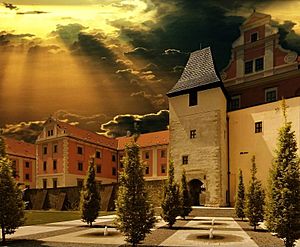
Palacký University Olomouc is the oldest university in Moravia. It is the second oldest in the Czech Republic. It was founded in 1573 to help bring Roman Catholicism back to the country. At that time, most people in the Czech lands were Protestants. Many of its departments were closed in the 1850s. This was because professors and students supported the 1848 revolution. The university was fully reopened in 1946.
The university is very important to the city. With over 25,200 students, Olomouc has the most university students per person in Central Europe. Many city services are designed for students. They might close during holidays or exam times. During summer holidays, trams run less often. But during university terms, more trams are used.
About a third of the city's historic center is made up of university buildings. Important ones include the University Art Centre and the Armoury, which is now the Central Library.
Sports in Olomouc
Olomouc has a professional football club called SK Sigma Olomouc. They play in the top Czech league. Their home games are at Andrův stadion, which can hold 12,474 people. This stadium also hosts international matches. Another football club in the city is 1. HFK Olomouc.
The city's ice hockey team is HC Olomouc. They play in the top Czech league. Their home games are at Zimní stadion Olomouc. RC Olomouc is a rugby club that plays in the third-tier league.
Next to Andrův stadion was a place called the Spartakiad Stadium. It was built after World War II. This stadium was used for many events, especially for the Spartakiad in the 1950s and 1960s. It also hosted motorcycle speedway races.
Places to See in Olomouc
Olomouc has several large squares. The main one has the Holy Trinity Column, which is a UNESCO World Heritage Site. This column is 115 ft (35 m) tall. It was built between 1716 and 1754.
The city has many old religious buildings. The most famous church is Saint Wenceslas Cathedral. It was founded before 1107 near the Olomouc Castle. The cathedral was rebuilt in the late 1800s in a new Gothic style. It still has parts from older styles, like a Romanesque crypt and Baroque chapels. The tallest of its three spires is 328 ft (100 m) high. This makes it the second-highest in the country. Next to the church is the Bishop Zdík's Palace, a Romanesque building from after 1141. This early bishop's palace is very special in Central Europe.
The Church of Saint Maurice is a beautiful Gothic building from the 15th century. It has the sixth-largest church organ in Central Europe.
Church of Saint Michael is also notable. The Chapel of Saint John Sarkander is a Neo-baroque building. It stands where an old town prison used to be. A Catholic priest named John Sarkander was imprisoned here during the Thirty Years' War. He was later made a saint by Pope John Paul II when the Pope visited Olomouc in 1995.
Pope John Paul II also visited Svatý Kopeček ("The Holy Hillock"). This place has the amazing Baroque Church of the Visitation of the Virgin Mary. It offers great views of the city. The Pope made this church a "Minor Basilica." Olomouc also has several monasteries, like Hradisko Monastery and the Convent of Dominican Sisters.
Other interesting places include the Olomouc Orthodox Church, dedicated to Saint Gorazd. There is also the Mausoleum of Yugoslav Soldiers. This monument remembers 1,188 soldiers from Yugoslavia. They died in local hospitals during World War I after being wounded.
The main non-religious building is the city hall. It was finished in the 15th century. It has a Gothic chapel, which is now the Olomouc Museum of Art. The city hall has a tower 250 ft (76 m) high. On the tower is an astronomical clock. The original 15th-century clock was damaged at the end of World War II. It was rebuilt from 1947 to 1955. The new clock shows workers instead of saints. This is why its calendar shows important days from the Communist era.
Olomouc has a special collection of six Baroque fountains. They were kept because the city leaders were careful. While other European cities removed old fountains, Olomouc kept them. They were useful as water sources in case of fire. The fountains show old Roman themes. Five of them feature Roman gods: Jupiter (image), Mercury (image), Triton (image), Neptune, and Hercules (image). One fountain shows Julius Caesar, who is said to have founded the city (image). In recent years, an Arion fountain was added to the main square.
In front of the astronomical clock on Horní ("Upper") Square, which is the largest square in Olomouc, there is a small bronze model of the entire old town.
Famous People from Olomouc
Public Service
- Joseph von Petrasch (1714–1772), soldier and writer
- Alexander von Krobatin (1849–1933), Austrian Field Marshal
- Zdeněk Fierlinger (1891–1976), diplomat and former prime minister of Czechoslovakia
- Jiří Pelikán (1923–1999), journalist and politician
- Pavel Dostál (1943–2005), Minister of Culture
- Jiří Paroubek (born 1952), politician and former Prime Minister
Religion
- Augustinus Olomucensis (1467–1513), humanist and theologian
- Archduke Rudolf of Austria (1788–1831), Archbishop of Olomouc
- John M. Oesterreicher (1904–1993), Catholic theologian who worked for Jewish–Catholic understanding
- Jan Graubner (born 1948), Roman Catholic archbishop
Science and Learning
- Valentin Stansel (1621–1705), Jesuit and astronomer
- Josef Vratislav Monse (1733–1793), lawyer, historian, and professor
- Anton Schrötter von Kristelli (1802–1875), Austrian chemist
- Olga Taussky-Todd (1906–1995), mathematician
- Jan G. Švec (born 1966), voice scientist
- Jaroslav Miller (born 1971), history professor and university rector
Arts and Entertainment
- Georg Flegel (1566–1638) German painter
- Gottfried Finger (1655/6–1730), composer
- Leo Fall (1873–1925), Austrian composer
- Adolf Kašpar (1877–1934), painter and illustrator
- Edgar G. Ulmer (1904–1972), Austrian-American film director
- Emil Viklický (born 1948), jazz pianist and composer
- Pavel Vítek (born 1962), singer and actor
- Veronika Vařeková (born 1977), model
Sports
- Evžen Rošický (1914–1942), athlete
- Karel Brückner (born 1939), football coach
- Jiří Hudler (born 1984), ice hockey player
- Karlos Vemola (born 1985), mixed martial artist
- Tomáš Kalas (born 1993), footballer
- Karolína Muchová (born 1996), tennis player
Sister Cities
Olomouc has special connections with these cities around the world:
 Antony, France
Antony, France Kraków, Poland
Kraków, Poland Kunming, China
Kunming, China Lucerne, Switzerland
Lucerne, Switzerland Makarska, Croatia
Makarska, Croatia Nördlingen, Germany
Nördlingen, Germany Old Town (Bratislava), Slovakia
Old Town (Bratislava), Slovakia Owensboro, United States
Owensboro, United States Pécs, Hungary
Pécs, Hungary Subotica, Serbia
Subotica, Serbia Tampere, Finland
Tampere, Finland Veenendaal, Netherlands
Veenendaal, Netherlands
Images for kids
See also
 In Spanish: Olomouc para niños
In Spanish: Olomouc para niños



